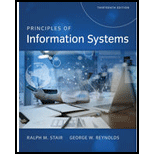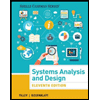
Principles of Information Systems, Loose-Leaf Version
13th Edition
ISBN: 9781305971820
Author: Ralph Stair, George Reynolds
Publisher: Course Technology
expand_more
expand_more
format_list_bulleted
Concept explainers
Expert Solution & Answer
Chapter 12, Problem 1SAT
Program Description Answer
Though maintenance and support costs are expensive, “Off-the-shelf” software is less risky and leads to quicker deployment.
Hence, the correct option is “C”.
Expert Solution & Answer
Explanation of Solution
Off-the-shelf:
- Off-the shelf software is readymade software which is designed for specific use or demand.
- Example: web browsers, applications, games and many others.
- Hence, it is easy to understand and implement.
Explanation for incorrect options:
Custom:
- Custom software is a type of software that is designed for specific organization or company or user.
- Example: Car manufacturing application
- It also known as bespoke software or tailor-made software.
Hence, the option “A” is wrong.
Enterprise:
- Enterprise software is a type of software that focuses on organization needs rather than individual or customer needs.
- Example: schools, clubs, governments and many such.
- It is also termed as Enterprise Application Software (EAS).
Hence, option “B” is wrong.
Personal productivity:
- Personal productivity software is a application software that is used for information like documents, graphs, digital applications, music and many such.
- Example: Google applications, Microsoft office, Zoho and many others.
- It is also known as office productivity software.
Hence, the option “D” is wrong.
Want to see more full solutions like this?
Subscribe now to access step-by-step solutions to millions of textbook problems written by subject matter experts!
Students have asked these similar questions
Hello please look at the attached picture. I need an detailed explanation of the architecture
Information Security Risk and Vulnerability Assessment
1- Which TCP/IP protocol is used to convert the IP address to the Mac address? Explain 2-What popular switch feature allows you to create communication boundaries between systems connected to the switch3- what types of vulnerability directly related to the programmer of the software?4- Who ensures the entity implements appropriate security controls to protect an asset?
Please do not use AI and add refrence
Find the voltage V0 across the 4K resistor using the mesh method or nodal analysis. Note: I have already simulated it and the value it should give is -1.714V
Chapter 12 Solutions
Principles of Information Systems, Loose-Leaf Version
Ch. 12.2 - Outline the tasks that must be accomplished to...Ch. 12.2 - Following your discussion, one of the team members...Ch. 12.2 - There is likely to be some confusion over the role...Ch. 12.2 - Prob. 2CTQCh. 12.3 - Prob. 1RQCh. 12.3 - Prob. 2RQCh. 12.3 - Prob. 1CTQCh. 12.3 - What other potential problems can you anticipate...Ch. 12.4 - Prob. 1RQCh. 12.4 - Prob. 2RQ
Ch. 12.4 - Prob. 1CTQCh. 12.4 - A safety-critical system is one whose failure or...Ch. 12 - Prob. 1SATCh. 12 - _______________ software can provide a better...Ch. 12 - Prob. 3SATCh. 12 - Prob. 4SATCh. 12 - The purpose of the system investigation phase is...Ch. 12 - ______________ is a diagram used to document the...Ch. 12 - The overall emphasis of the __________ phase is on...Ch. 12 - The primary tool for assessing the software...Ch. 12 - Prob. 9SATCh. 12 - Prob. 10SATCh. 12 - Prob. 11SATCh. 12 - Prob. 12SATCh. 12 - A preliminary evaluation of software packages and...Ch. 12 - Prob. 1RQCh. 12 - Prob. 2RQCh. 12 - Prob. 3RQCh. 12 - Prob. 4RQCh. 12 - Prob. 5RQCh. 12 - What are the key elements of a system...Ch. 12 - Prob. 7RQCh. 12 - Prob. 8RQCh. 12 - Prob. 9RQCh. 12 - Prob. 10RQCh. 12 - Prob. 11RQCh. 12 - Prob. 12RQCh. 12 - Prob. 13RQCh. 12 - Prob. 14RQCh. 12 - An organization has selected and is now...Ch. 12 - Prob. 1DQCh. 12 - Thoroughly discuss the pros and cons of buying...Ch. 12 - Prob. 3DQCh. 12 - Prob. 4DQCh. 12 - Prob. 5DQCh. 12 - Prob. 6DQCh. 12 - Prob. 7DQCh. 12 - Define the Pareto principle, and discuss how it...Ch. 12 - Prob. 9DQCh. 12 - Prob. 10DQCh. 12 - Prob. 11DQCh. 12 - Prob. 12DQCh. 12 - Identify and briefly discuss four key tasks...Ch. 12 - A new sales ordering system needs a relational...Ch. 12 - Prob. 2TACh. 12 - You and your team have been hired to perform a...Ch. 12 - Prob. 1WECh. 12 - Prob. 2WECh. 12 - Do research to determine the current level of...Ch. 12 - Prob. 1CECh. 12 - Prob. 2CECh. 12 - Identify an information system frequently employed...Ch. 12 - It is perhaps not surprising that Etsy was an...Ch. 12 - Prob. 2CTQ1Ch. 12 - What would be some of the criteria you would use...Ch. 12 - Prob. 1CTQ2Ch. 12 - Prob. 2CTQ2Ch. 12 - Prob. 3CTQ2
Knowledge Booster
Learn more about
Need a deep-dive on the concept behind this application? Look no further. Learn more about this topic, computer-science and related others by exploring similar questions and additional content below.Similar questions
- Briefly describe the issues involved in using ATM technology in Local Area Networksarrow_forwardFor this question you will perform two levels of quicksort on an array containing these numbers: 59 41 61 73 43 57 50 13 96 88 42 77 27 95 32 89 In the first blank, enter the array contents after the top level partition. In the second blank, enter the array contents after one more partition of the left-hand subarray resulting from the first partition. In the third blank, enter the array contents after one more partition of the right-hand subarray resulting from the first partition. Print the numbers with a single space between them. Use the algorithm we covered in class, in which the first element of the subarray is the partition value. Question 1 options: Blank # 1 Blank # 2 Blank # 3arrow_forward1. Transform the E-R diagram into a set of relations. Country_of Agent ID Agent H Holds Is_Reponsible_for Consignment Number $ Value May Contain Consignment Transports Container Destination Ф R Goes Off Container Number Size Vessel Voyage Registry Vessel ID Voyage_ID Tonnagearrow_forward
- I want to solve 13.2 using matlab please helparrow_forwarda) Show a possible trace of the OSPF algorithm for computing the routing table in Router 2 forthis network.b) Show the messages used by RIP to compute routing tables.arrow_forwardusing r language to answer question 4 Question 4: Obtain a 95% standard normal bootstrap confidence interval, a 95% basic bootstrap confidence interval, and a percentile confidence interval for the ρb12 in Question 3.arrow_forward
arrow_back_ios
SEE MORE QUESTIONS
arrow_forward_ios
Recommended textbooks for you
 Principles of Information Systems (MindTap Course...Computer ScienceISBN:9781285867168Author:Ralph Stair, George ReynoldsPublisher:Cengage Learning
Principles of Information Systems (MindTap Course...Computer ScienceISBN:9781285867168Author:Ralph Stair, George ReynoldsPublisher:Cengage Learning Fundamentals of Information SystemsComputer ScienceISBN:9781337097536Author:Ralph Stair, George ReynoldsPublisher:Cengage Learning
Fundamentals of Information SystemsComputer ScienceISBN:9781337097536Author:Ralph Stair, George ReynoldsPublisher:Cengage Learning Principles of Information Systems (MindTap Course...Computer ScienceISBN:9781305971776Author:Ralph Stair, George ReynoldsPublisher:Cengage Learning
Principles of Information Systems (MindTap Course...Computer ScienceISBN:9781305971776Author:Ralph Stair, George ReynoldsPublisher:Cengage Learning Fundamentals of Information SystemsComputer ScienceISBN:9781305082168Author:Ralph Stair, George ReynoldsPublisher:Cengage Learning
Fundamentals of Information SystemsComputer ScienceISBN:9781305082168Author:Ralph Stair, George ReynoldsPublisher:Cengage Learning Information Technology Project ManagementComputer ScienceISBN:9781337101356Author:Kathy SchwalbePublisher:Cengage Learning
Information Technology Project ManagementComputer ScienceISBN:9781337101356Author:Kathy SchwalbePublisher:Cengage Learning Systems Analysis and Design (Shelly Cashman Serie...Computer ScienceISBN:9781305494602Author:Scott Tilley, Harry J. RosenblattPublisher:Cengage Learning
Systems Analysis and Design (Shelly Cashman Serie...Computer ScienceISBN:9781305494602Author:Scott Tilley, Harry J. RosenblattPublisher:Cengage Learning

Principles of Information Systems (MindTap Course...
Computer Science
ISBN:9781285867168
Author:Ralph Stair, George Reynolds
Publisher:Cengage Learning

Fundamentals of Information Systems
Computer Science
ISBN:9781337097536
Author:Ralph Stair, George Reynolds
Publisher:Cengage Learning

Principles of Information Systems (MindTap Course...
Computer Science
ISBN:9781305971776
Author:Ralph Stair, George Reynolds
Publisher:Cengage Learning

Fundamentals of Information Systems
Computer Science
ISBN:9781305082168
Author:Ralph Stair, George Reynolds
Publisher:Cengage Learning

Information Technology Project Management
Computer Science
ISBN:9781337101356
Author:Kathy Schwalbe
Publisher:Cengage Learning

Systems Analysis and Design (Shelly Cashman Serie...
Computer Science
ISBN:9781305494602
Author:Scott Tilley, Harry J. Rosenblatt
Publisher:Cengage Learning